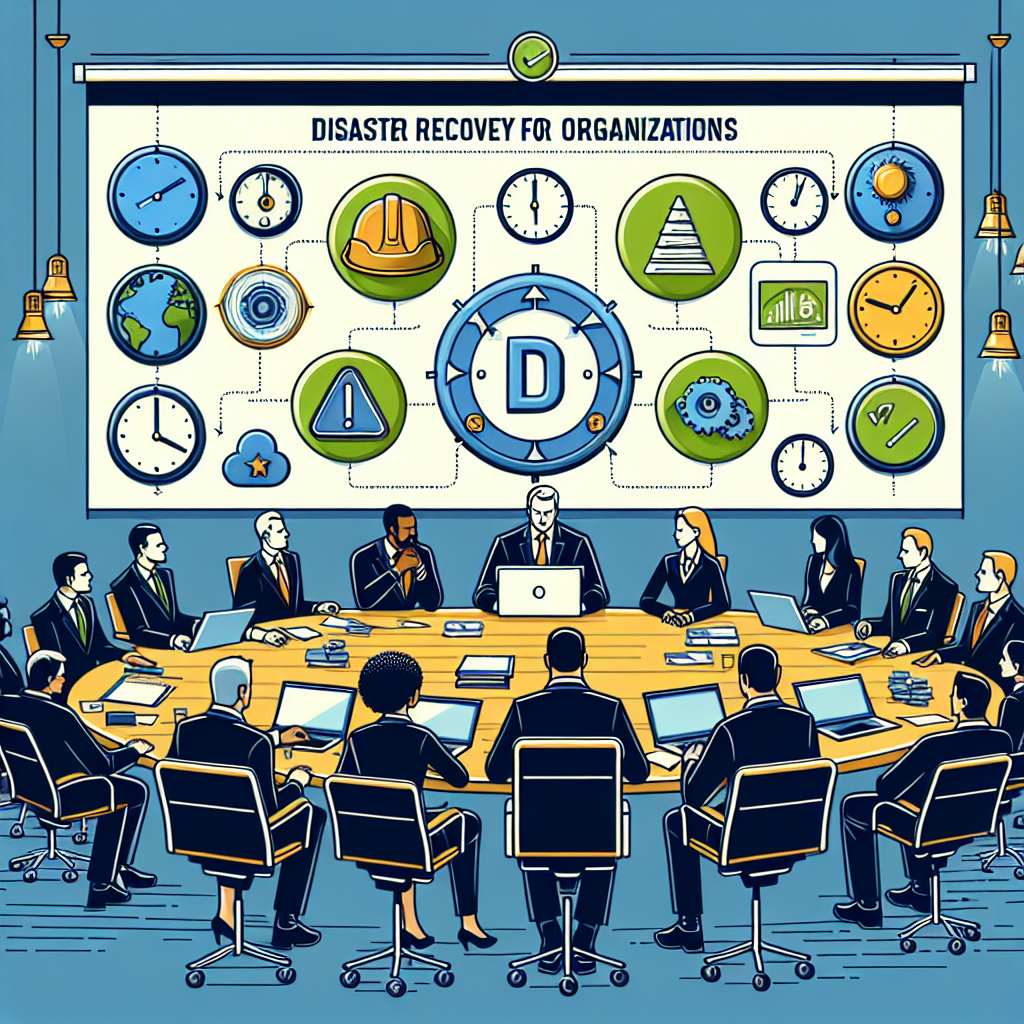Your cart is currently empty!
Tag: Comprehensive

Disaster Recovery: A Comprehensive Guide for Businesses
Disasters can strike at any moment, leaving businesses vulnerable to the aftermath of destruction and chaos. From natural disasters like hurricanes and earthquakes to man-made disasters such as cyberattacks and data breaches, it is crucial for businesses to have a comprehensive disaster recovery plan in place to mitigate the impact and ensure business continuity.Disaster recovery is the process of planning for and responding to disasters in order to minimize downtime and recover critical business functions. A well-thought-out disaster recovery plan can mean the difference between a business surviving or collapsing in the face of adversity.
The first step in creating a disaster recovery plan is to conduct a risk assessment to identify potential threats and vulnerabilities that could disrupt business operations. This assessment should include a thorough analysis of the business’s infrastructure, data, and critical systems to determine the potential impact of different types of disasters.
Once potential risks have been identified, the next step is to develop a comprehensive disaster recovery plan that outlines the steps and procedures to be followed in the event of a disaster. This plan should include details on how to protect critical data and systems, how to communicate with employees and stakeholders, and how to restore operations as quickly as possible.
Key components of a disaster recovery plan include:
– Data backup and recovery: Regularly backing up data is essential to ensure that critical information can be restored in the event of a disaster. Businesses should have a robust backup system in place, with offsite storage to prevent data loss in the event of physical damage to the primary storage location.
– Communication plan: Clear communication is key during a disaster, both internally with employees and externally with customers, suppliers, and other stakeholders. A communication plan should outline the chain of command, communication channels, and procedures for updating stakeholders on the status of recovery efforts.
– Testing and training: It is essential to regularly test and update the disaster recovery plan to ensure that it remains effective and responsive to evolving threats. Employees should be trained on their roles and responsibilities in the event of a disaster and participate in regular drills to prepare for potential scenarios.
– Vendor and supplier relationships: Businesses should maintain strong relationships with vendors and suppliers to ensure continuity of operations in the event of a disaster. This may include establishing backup suppliers, contractual agreements for priority service during emergencies, and regular communication to ensure mutual support.
In conclusion, disaster recovery is a critical aspect of business resilience and continuity planning. By taking proactive steps to assess risks, develop a comprehensive plan, and regularly test and update procedures, businesses can minimize the impact of disasters and ensure that they can recover quickly and effectively. Investing in disaster recovery is an investment in the future of the business, protecting assets, reputation, and ultimately, survival.

Managed Service Providers: A Comprehensive Guide for Businesses.
In today’s fast-paced and highly competitive business environment, organizations are constantly looking for ways to improve their efficiency, reduce costs, and stay ahead of the curve. One avenue that many businesses are turning to is managed service providers (MSPs). Managed service providers are third-party companies that offer a wide range of IT services to businesses, from network monitoring and security to data backup and disaster recovery.Managed service providers can provide businesses with a variety of benefits, including cost savings, improved security, and increased efficiency. By outsourcing their IT needs to a managed service provider, businesses can focus on their core competencies and leave the technical details to the experts.
One of the key benefits of working with a managed service provider is cost savings. By outsourcing their IT needs to a third-party provider, businesses can avoid the high costs associated with hiring and training in-house IT staff. Managed service providers typically offer their services for a fixed monthly fee, which can help businesses budget more effectively and avoid unexpected costs.
Managed service providers can also help businesses improve their security posture. With cyber threats on the rise, it’s essential for businesses to have robust security measures in place to protect their sensitive data. Managed service providers can offer a range of security services, including network monitoring, intrusion detection, and data encryption, to help businesses safeguard their information and prevent cyber attacks.
In addition to cost savings and improved security, managed service providers can also help businesses increase their efficiency. By outsourcing their IT needs to a third-party provider, businesses can access the latest technology and tools without having to invest in expensive hardware and software themselves. Managed service providers can also provide round-the-clock support and monitoring, ensuring that businesses have access to the support they need whenever they need it.
Overall, working with a managed service provider can offer businesses a wide range of benefits, from cost savings and improved security to increased efficiency and access to the latest technology. By partnering with a managed service provider, businesses can focus on their core competencies and leave the technical details to the experts, allowing them to stay ahead of the curve and drive business growth.

How MSPs Can Transform Your Business: A Comprehensive Overview
Managed Service Providers (MSPs) have become an essential part of modern businesses, providing a wide range of services to help organizations improve their efficiency, security, and overall performance. In this article, we will provide a comprehensive overview of how MSPs can transform your business and help you achieve your goals.One of the key ways that MSPs can transform your business is by providing proactive IT support and management. Instead of waiting for problems to arise and then reacting to them, MSPs work to prevent issues before they occur. This proactive approach can help minimize downtime, improve productivity, and ensure that your systems are always running smoothly. By monitoring your IT infrastructure 24/7, MSPs can identify potential issues early on and address them before they become major problems.
In addition to proactive support, MSPs also offer a range of services to help businesses improve their cybersecurity posture. With the increasing number of cyber threats targeting organizations of all sizes, it is more important than ever to have robust security measures in place. MSPs can help implement and manage security solutions such as firewalls, antivirus software, and intrusion detection systems to protect your data and systems from cyber attacks. They can also provide employee training to help educate your staff on best practices for staying safe online.
Furthermore, MSPs can help businesses leverage the latest technology to improve their operations and stay ahead of the competition. Whether you need help migrating to the cloud, implementing new software solutions, or upgrading your hardware, MSPs have the expertise and resources to help you make the most of your technology investments. By staying up-to-date on the latest industry trends and advancements, MSPs can recommend the right solutions to meet your specific needs and help you achieve your business objectives.
Another way that MSPs can transform your business is by providing strategic guidance and support. With their in-depth knowledge of technology and business processes, MSPs can help you develop a technology roadmap that aligns with your long-term goals and objectives. By understanding your business needs and challenges, MSPs can recommend solutions that will help you streamline your operations, improve efficiency, and drive growth. They can also provide ongoing support and guidance to ensure that your technology infrastructure continues to meet your evolving needs.
In conclusion, MSPs can play a crucial role in transforming your business by providing proactive IT support, enhancing your cybersecurity defenses, leveraging the latest technology, and offering strategic guidance. By partnering with an MSP, you can free up your internal IT resources to focus on core business activities while benefiting from the expertise and resources of a dedicated team of IT professionals. If you want to take your business to the next level and stay ahead of the competition, consider partnering with an MSP to help you achieve your goals.

Preparing for the Worst: How to Develop a Comprehensive Disaster Recovery Plan
In today’s unpredictable world, it is essential for businesses to have a comprehensive disaster recovery plan in place. Disasters can strike at any time, whether it be a natural disaster such as a hurricane or earthquake, or a man-made disaster such as a cyber attack or data breach. Having a well-thought-out plan in place can mean the difference between a business bouncing back quickly or suffering irreparable damage.Developing a disaster recovery plan requires careful planning and coordination across all levels of an organization. Here are some key steps to consider when developing a comprehensive disaster recovery plan:
1. Identify potential risks: The first step in developing a disaster recovery plan is to identify potential risks that could impact your business. This could include natural disasters, cyber attacks, equipment failures, or even human error. By understanding the potential risks, you can better prepare for them and mitigate their impact.
2. Assess critical functions and resources: Once you have identified potential risks, it is important to assess your critical functions and resources that are essential for your business to operate. This could include key personnel, IT systems, data, and physical assets. By prioritizing these functions and resources, you can ensure that they are protected and restored in the event of a disaster.
3. Develop a communication plan: Communication is key during a disaster, both internally within your organization and externally with customers, suppliers, and other stakeholders. Develop a communication plan that outlines how information will be shared during a disaster, who is responsible for communicating with whom, and how updates will be provided.
4. Implement backup and recovery solutions: To ensure that your critical data and systems are protected, it is important to implement backup and recovery solutions. This could include offsite backups, cloud storage, redundant systems, and regular testing of your backup and recovery processes.
5. Train your staff: Your employees are a critical part of your disaster recovery plan. Make sure that they are trained on how to respond in the event of a disaster, including their roles and responsibilities, evacuation procedures, and how to access critical systems and data.
6. Test and update your plan regularly: A disaster recovery plan is only effective if it is regularly tested and updated. Conduct regular drills and exercises to ensure that your plan is effective and that your staff is prepared to respond in the event of a disaster. Update your plan as needed based on lessons learned from these exercises and changes in your business operations.
By following these steps and developing a comprehensive disaster recovery plan, your business can better prepare for the worst and minimize the impact of a disaster. Remember, it is not a matter of if a disaster will strike, but when. It is important to be proactive and prepared to ensure the continuity of your business operations in the face of adversity.

The ABCs of Disaster Recovery: A Comprehensive Guide for Organizations
Disasters can strike at any moment, causing chaos and disruption to businesses of all sizes. Whether it’s a natural disaster like a hurricane or earthquake, or a man-made disaster like a cyber attack or equipment failure, having a solid disaster recovery plan in place is essential for organizations to minimize downtime and ensure business continuity.The ABCs of disaster recovery refer to the key components that organizations need to consider when creating a comprehensive disaster recovery plan. By following these steps, organizations can better prepare for and recover from disasters, ensuring that they can continue to operate and serve their customers even in the face of adversity.
A – Assess Risks: The first step in creating a disaster recovery plan is to assess the potential risks that your organization faces. This includes identifying potential threats, such as natural disasters, cyber attacks, or equipment failures, and understanding the potential impact that these events could have on your business operations. By conducting a thorough risk assessment, organizations can better prioritize their disaster recovery efforts and allocate resources effectively.
B – Backup Data: One of the most critical components of a disaster recovery plan is ensuring that your organization’s data is backed up regularly and securely. This includes backing up both on-site and off-site, as well as implementing data encryption and other security measures to protect sensitive information. By regularly backing up data, organizations can minimize data loss in the event of a disaster and ensure that they can quickly recover and resume operations.
C – Create a Continuity Plan: In addition to backing up data, organizations should also create a business continuity plan that outlines how they will continue to operate in the event of a disaster. This plan should include detailed procedures for responding to different types of disasters, as well as communication protocols for keeping employees, customers, and other stakeholders informed. By having a solid business continuity plan in place, organizations can minimize downtime and ensure that they can quickly recover and resume normal operations.
D – Determine Recovery Time Objectives: Recovery time objectives (RTOs) are the maximum amount of time that an organization can afford to be without certain critical systems or services. By determining RTOs for different systems and processes, organizations can better prioritize their recovery efforts and allocate resources effectively. This helps ensure that critical systems are restored quickly, minimizing the impact of a disaster on business operations.
E – Establish Recovery Teams: Finally, organizations should establish recovery teams that are responsible for implementing and executing the disaster recovery plan. These teams should include key stakeholders from across the organization, as well as external partners and vendors who can provide support and expertise during a disaster. By having dedicated recovery teams in place, organizations can ensure a coordinated and effective response to disasters, minimizing downtime and ensuring business continuity.
In conclusion, the ABCs of disaster recovery provide organizations with a comprehensive guide for creating a solid disaster recovery plan. By following these key steps, organizations can better prepare for and recover from disasters, ensuring that they can continue to operate and serve their customers even in the face of adversity. By assessing risks, backing up data, creating a continuity plan, determining RTOs, and establishing recovery teams, organizations can minimize downtime and ensure business continuity in the event of a disaster.

Creating a Plan for Success: Steps to Implementing a Comprehensive Business Continuity Program
In today’s fast-paced and unpredictable business environment, it is crucial for organizations to have a comprehensive business continuity program in place. This program ensures that businesses can continue to operate smoothly and effectively in the face of unexpected disruptions, such as natural disasters, cyber attacks, or other emergencies.Creating a plan for success in implementing a comprehensive business continuity program involves several key steps. By following these steps, organizations can better prepare for potential threats and minimize the impact of disruptions on their operations.
1. Conduct a risk assessment: The first step in creating a business continuity program is to identify and assess potential risks that could affect the organization. This includes conducting a thorough analysis of the various threats that could impact the business, such as natural disasters, cyber attacks, or supply chain disruptions.
2. Develop a business impact analysis: Once the risks have been identified, it is important to assess the potential impact of these risks on the organization. This includes determining the critical functions and processes that are essential for the business to operate effectively, as well as the potential financial and operational consequences of disruptions.
3. Develop a comprehensive plan: Based on the results of the risk assessment and business impact analysis, organizations should develop a comprehensive business continuity plan that outlines the steps and procedures to be followed in the event of a disruption. This plan should include detailed instructions for responding to different types of emergencies, as well as a communication plan for keeping employees, customers, and other stakeholders informed.
4. Implement training and testing: Once the business continuity plan has been developed, it is important to ensure that employees are properly trained on the procedures outlined in the plan. Regular training exercises and drills can help ensure that employees are prepared to respond effectively in the event of a disruption. Additionally, organizations should regularly test and update their business continuity plan to ensure that it remains effective and up-to-date.
5. Establish a communication plan: Effective communication is key to successfully implementing a business continuity program. Organizations should establish a communication plan that outlines how information will be shared with employees, customers, and other stakeholders during an emergency. This plan should include contact information for key personnel, as well as procedures for updating stakeholders on the status of the business.
By following these steps and implementing a comprehensive business continuity program, organizations can better prepare for potential disruptions and ensure that they are able to continue operating effectively in the face of unexpected events. With a solid plan in place, businesses can minimize the impact of disruptions on their operations and maintain the trust and confidence of their customers and stakeholders.

Maximizing ROI with Managed Services: A Comprehensive Overview
In today’s competitive business landscape, maximizing return on investment (ROI) is essential for staying ahead of the curve. One way companies are achieving this is through the use of managed services. Managed services offer businesses the opportunity to outsource their IT needs to a third-party provider, allowing them to focus on their core business activities while benefiting from the expertise and resources of a dedicated team.There are several key ways in which managed services can help companies maximize their ROI. Firstly, by outsourcing their IT needs, companies can reduce costs associated with hiring and training in-house IT staff. Managed services providers typically offer flexible pricing models, allowing businesses to pay only for the services they need, when they need them. This can result in significant cost savings over time.
Furthermore, managed services providers often have access to the latest technology and tools, which can help companies improve their operational efficiency and productivity. By leveraging the expertise of a managed services team, companies can ensure that their IT infrastructure is up-to-date and secure, reducing the risk of costly downtime and data breaches.
Another key benefit of managed services is the ability to scale resources as needed. As businesses grow and evolve, their IT needs may change. Managed services providers can quickly and easily adjust their services to meet the changing needs of their clients, ensuring that they have the resources they need to support their growth and success.
In addition, by outsourcing their IT needs to a managed services provider, companies can free up valuable time and resources that can be reinvested in other areas of their business. This can lead to increased innovation, improved customer service, and ultimately, greater profitability.
Overall, maximizing ROI with managed services is a smart business decision for companies of all sizes. By outsourcing their IT needs to a third-party provider, businesses can reduce costs, improve efficiency, and focus on their core business activities. This can result in a significant return on investment over time, making managed services a valuable asset for companies looking to stay competitive in today’s fast-paced business environment.

Preparing for the Unexpected: Creating a Comprehensive Disaster Recovery Plan
In today’s unpredictable world, it is essential for businesses to be prepared for any unexpected disasters that may come their way. Whether it’s a natural disaster such as a hurricane or earthquake, or a man-made disaster like a cyber attack or data breach, having a comprehensive disaster recovery plan in place is crucial for minimizing the impact on your business.Creating a disaster recovery plan involves identifying potential risks and developing strategies to mitigate them. This process should involve input from key stakeholders within your organization, including IT professionals, risk management teams, and senior management. By working together, you can identify the most critical systems and processes within your organization that need to be protected in the event of a disaster.
One of the first steps in creating a disaster recovery plan is to conduct a risk assessment. This involves identifying potential threats to your business, such as natural disasters, cyber attacks, or equipment malfunctions. Once you have identified these risks, you can then prioritize them based on their potential impact on your business. This will help you to determine where to focus your resources and efforts in developing your recovery plan.
Next, you will need to develop a comprehensive set of procedures for responding to each type of disaster. This may include steps for restoring data, recovering systems, and communicating with employees and customers. It is important to test these procedures regularly to ensure that they are effective and up-to-date.
In addition to developing procedures for responding to disasters, it is also important to have a communication plan in place. This should include contact information for key employees, vendors, and customers, as well as a plan for keeping stakeholders informed during a crisis. Clear communication is essential for maintaining trust and confidence in your business during a disaster.
Finally, it is important to regularly review and update your disaster recovery plan to ensure that it remains effective. As your business evolves and new threats emerge, your plan should be adjusted accordingly. By staying proactive and prepared, you can minimize the impact of unexpected disasters on your business and ensure a swift recovery.
In conclusion, creating a comprehensive disaster recovery plan is essential for businesses of all sizes. By identifying risks, developing response procedures, and maintaining clear communication, you can minimize the impact of disasters and ensure the continuity of your business operations. Don’t wait until it’s too late – start preparing for the unexpected today.

Understanding Service Level Agreements: A Comprehensive Guide for Businesses
In today’s fast-paced business environment, ensuring high-quality service delivery is crucial for maintaining customer satisfaction and loyalty. Service Level Agreements (SLAs) are a key tool that businesses can use to define the level of service they expect from their service providers and ensure that their needs are met.What is a Service Level Agreement?
A Service Level Agreement is a contract between a service provider and a customer that outlines the level of service that will be provided, as well as the metrics used to measure performance. SLAs typically include details such as service availability, response times, and resolution times for issues or incidents.
Why are SLAs important for businesses?
SLAs are important for businesses because they provide a clear framework for measuring and monitoring service delivery. By establishing clear expectations and performance targets, SLAs help to ensure that both parties are on the same page and that services are delivered according to agreed-upon standards.
Key components of a Service Level Agreement
When creating an SLA, there are several key components that should be included to ensure that both parties understand their roles and responsibilities. These components may include:
1. Service description: A detailed description of the services that will be provided, including any specific requirements or deliverables.
2. Service levels: Specific performance metrics that will be used to measure service delivery, such as availability, response times, and resolution times.
3. Responsibilities: Clear delineation of the responsibilities of both the service provider and the customer, including who is responsible for what tasks and activities.
4. Escalation procedures: Procedures for escalating issues or incidents that are not resolved within the agreed-upon timeframes.
5. Reporting and monitoring: Processes for monitoring service performance and reporting on key metrics to ensure that performance targets are being met.
Benefits of using SLAs for businesses
There are several benefits to using SLAs for businesses, including:
1. Improved service quality: By clearly defining service levels and expectations, businesses can ensure that services are delivered according to agreed-upon standards.
2. Enhanced customer satisfaction: SLAs help to establish clear communication and expectations between service providers and customers, leading to higher levels of customer satisfaction.
3. Increased accountability: SLAs hold service providers accountable for meeting performance targets and provide a framework for addressing issues or incidents that may arise.
4. Cost savings: By defining service levels and responsibilities upfront, businesses can avoid costly disputes and ensure that services are delivered efficiently.
In conclusion, Service Level Agreements are a valuable tool for businesses looking to ensure high-quality service delivery and maintain strong relationships with their service providers. By clearly defining expectations, responsibilities, and performance metrics, businesses can effectively monitor and measure service delivery, leading to improved customer satisfaction and operational efficiency.

Why Every Business Needs a Comprehensive Disaster Recovery Strategy
In today’s fast-paced and technology-driven world, businesses are increasingly reliant on their data and technology systems to operate efficiently and effectively. However, with this increased reliance comes the risk of potential disasters that could disrupt operations and compromise important data.Whether it’s a natural disaster, such as a hurricane or earthquake, a cyber-attack, or a simple hardware failure, any of these events could have devastating consequences for a business. This is why it’s crucial for every business to have a comprehensive disaster recovery strategy in place.
A disaster recovery strategy is a plan that outlines how a business will respond to and recover from a disaster. This plan should include a detailed analysis of potential risks, as well as a roadmap for how the business will continue operations in the event of a disaster.
One of the key reasons why every business needs a comprehensive disaster recovery strategy is to protect its data. Data is one of the most valuable assets for any business, and losing it could have catastrophic consequences. A disaster recovery strategy ensures that data is backed up and stored securely, so that it can be quickly recovered in the event of a disaster.
Another important reason for having a disaster recovery strategy is to minimize downtime. Downtime can be incredibly costly for a business, as it can result in lost revenue, damaged reputation, and decreased productivity. A disaster recovery strategy helps to ensure that operations can be quickly restored following a disaster, minimizing the impact on the business.
Additionally, a comprehensive disaster recovery strategy can also help to ensure compliance with regulatory requirements. Many industries have strict regulations around data protection and security, and failing to have a proper disaster recovery plan in place could result in costly fines and penalties.
In conclusion, every business, regardless of size or industry, needs to have a comprehensive disaster recovery strategy in place. By protecting data, minimizing downtime, and ensuring compliance with regulations, a disaster recovery strategy can help to safeguard the future of a business and ensure its continued success. Don’t wait until disaster strikes – start developing your disaster recovery strategy today.
